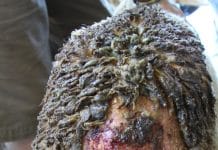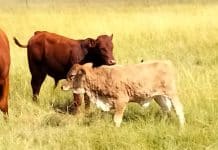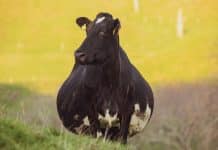Estimated reading time: 4 minutes
In last’s month’s article I focussed on horizontal fissures in dairy and beef cattle. There is a difference between horizontal and vertical fissures, and I want to explain the latter in more detail.
A vertical fissure can be described as a fissure or crack on the claw. In the early stages this is only visible higher up in the claw, close to the hairline, but always in a vertical direction. In advanced stages it runs from the hairline at the top of the claw all the way down to the bottom of the claw. Unlike horizontal grooves, vertical fissures do not appear on all claws, and in many cases only on some of the front claws.

Vertical fissures are commonly seen in beef cattle. It can result in severe lameness and many an animal has been slaughtered, especially in the stud industry, because of this condition.
Management and environment
In the first few articles in this series, I explained that hoof problems may sometimes be attributed to genetics, while management and the environment can also play a role. Where fissures are concerned, changes to on-farm management and the environment may mitigate or even prevent this problem in animals.

The first thing I would investigate is the mineral content of the licks – licks must contain the correct balance of minerals, especially zinc. If this is not the problem, I would look at water trough management.
When in open veld, cattle would walk into a river, pan or dam in order to drink water. They would stand with their front feet in the mud or water, which moisturises the feet. With intensively farmed cattle a stricter regimen is often followed. The soil around water troughs is kept clean and dry. Under these dry conditions, the periople tends to dry out and become damaged. The function of the periople is to help moisture flow through the tubules into the hoof wall, therefore ensuring supple and moist claws.
Extended periods of drought, sandy conditions, as well as a dry periople can all cause a small crack or separation in the hoof close to the hairline. If this problem is not addressed timeously by a professional hoof trimmer, the separation will eventually affect the hoof wall. This will cause the separation to lengthen as the hoof grows out from top to bottom. In such cases, a vertical fissure that runs all the way from the hairline to the bottom will be visible.
Lameness in cattle
Vertical fissures that develop in the dry periods of the year normally do not cause lameness. However, anaerobic bacterial infection can occur inside the fissure during wet conditions, setting the stage for the development of lameness. A professional hoof trimmer needs to restrain such an animal, remove the fissure and thin out the horn around the lesion. It is crucial to fix a block on the sound claw in order to elevate and rest the infected claw.
Preventive measures
Precautions can be taken to make sure the area around the water troughs are not too dry. This can be done by dumping the water on the ground around the troughs while they are being cleaned. – Jaco de Bruin, consultant, Dairysmid
qqqqq







